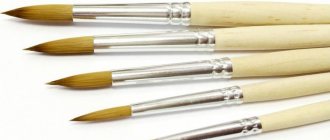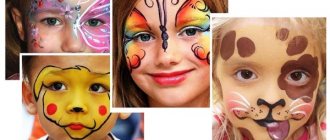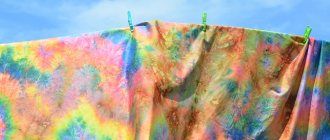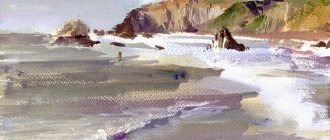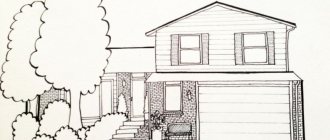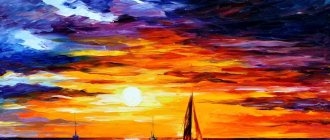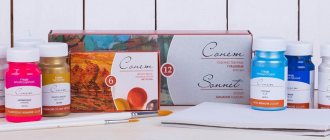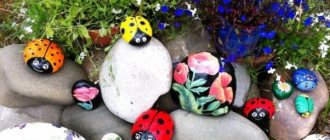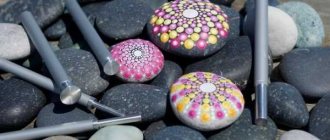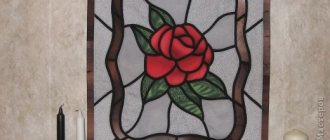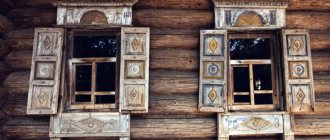A box of paints can give you an exciting journey into the world of fantasy. Amazing images, enchanting landscapes, and fairy-tale characters will come to life on the canvas. You can learn how to create drawings with pencil and paints using instructions and step-by-step recommendations. Prepare a set of brushes and paper, sponges and napkins, simple pencils and sponges. Be patient and get started! Drawings with paints for beginners - that's what we'll talk about today.
Let's look at drawing methods for beginners with three types of paint:
- watercolor;
- acrylic;
- gouache
Study this review and choose what you will be more comfortable working with when doing drawings for beginners. So, let's learn to paint!
Easy drawings with paints for beginners in watercolors step by step
The best option is to draw a landscape. For example, this sunset in pink tones.
In order to make such a drawing, in addition to a blank sheet of paper and a brush, you will need to prepare four colors of paint: pink, blue (ultramarine), dark yellow and black.
We start with yellow, mix the paint with water, making the color saturated. After this, we begin to paint the sheet with a brush.
So, the background was applied. Now, as in the final version, you need to draw the sun. In the place where you plan to do it, wipe the area with a dry cloth. Making a white circle. The result should be the following.
Now add pink to the yellow color and mix to get an orange color. We put this new color on top of the yellow, but so that there is a yellow halo around the sun.
Now we take only pink paint and apply it in a third layer so that the sky has a slightly more pink tint.
Applying blue skies
You need to add a little blue color to the upper part of the sky. We apply ultramarine at the top of the picture. If the blue color begins to mix with the previously applied yellow, you can remove the previous shade with a cloth and apply the blue directly. Before each application of paint, the brush must be wiped with a cloth so that it is dry.
Now mix pink and ultramarine. The result will be a violet or purple hue. We apply it below the blue color. Subsequently, this will give the sky a more evening appearance.
Now, using the same pink and blue colors, we make a darker, rich purple shade. Here you will have to experiment with the amount of paint. Before applying the finished shade, apply it to a strip of paper. If you are happy with the color, then paint it; if not, we continue mixing further.
Using the resulting color scheme, we draw stripes of clouds parallel to the horizon.
We will also draw several stripes of clouds on the right side of the picture, where the sun is. So that the clouds are not very contrasting, they need to be blurred a little. To do this, take a dry brush and blur the painted purple clouds with it.
If the previous stages were drawn on wet paper, then subsequent drawings should be done on a dry sheet. Therefore, we wait for some time for the sheet to dry. After it becomes dry, we begin drawing the horizon. Take a light purple color and draw a horizon line with a thin brush tip.
Now the upper part of the drawing, above the horizon line, needs to be made somewhat pinkish. Take the pink color and apply it. To make it softer and more blurry, add a little water and “smear” the pink paint with water.
Then we move to the lower part below the horizon line. We draw the water and the shore. Since we have a sunset, a pink evening, we will paint the water pink.
After the water we move to the shore
To do this, take the intense purple we used to paint earlier and mix it with black paint. We get a dark shade for the shore, which we use to paint under the waves. We also make a few dark strokes for the water itself.
All that remains is to apply a few adjustments in the sky area; if you are not satisfied with it, use a dry brush under the horizon to blur the paint, making it look like glare from the sun on the water. That's the whole drawing. Perhaps something won’t work out right away, but with patience you can get the hang of it, and then everything will go like clockwork.
How to organize a drawing lesson for children 3-4 years old?
- Think about the activity. Play out in your mind the entire sequence of what you and your child will do. Stock up on wet wipes and cloths so that you have them at hand if necessary.
- Give an example of what should happen as a result of the lesson. This can make it very easy to explain the material.
- Take a doll, animal or cartoon character and conduct an activity with its help. Children will be happy to support and help the puppet teacher.
- Think about what photographs, pictures, videos and audio materials you can use in class. This will make your lesson fun and interesting.
How to paint gouache on paper, an example for beginners
Another common drawing material is gouache. This paint is now used much more often than watercolor, especially when children paint. In this section, we will try to draw a flower using gouache:
As you can see, it is drawn on a black background. You can use a white background, but a red flower on a black background looks much better. Therefore, we take either a black sheet, or apply black paint to a white sheet as a background. In the second case, you will have to wait until the sheet dries.
We start by taking a pencil (light, since the background is dark) and drawing a flower with a pencil.
At the next stage you will need orange color, which will need to be used to paint over the flower.
Then take the red color and paint over the tips of the petals, as shown in the sample. We make the border between yellow and red not even, but slightly jagged.
Now the yellow color comes into play again. We use it to paint the inside of the flower, making strokes similar to those painted in red.
Now let's start drawing the middle of the flower. Paint the middle with red. After this we draw the stamens in green.
Drawing courses
Learning to paint with watercolors on your own is interesting, but terribly time consuming! When there is an experienced artist nearby who will help you see and correct mistakes, things will go much faster.
How to choose drawing courses so that they are effective and you do not waste your money? Answer yourself the question: “Why do I want to learn how to draw?”
If you are determined and want to reach the level of at least Michelangelo in order to enter a university or paint professionally, pay attention to academic drawing courses.
Start by studying the program. What does the school want to offer you? Do you find it too easy or too difficult for your level?
Often, art schools break classes into thematic units such as “Fundamentals of Head Drawing” or “Tone Drawing.” On average, such blocks can last from 14 to 72 academic hours .
The cost will also be different: from 3,000 to 10,000 rubles .
If you are more interested in drawing as a hobby or want to master one or two techniques, pay attention to master classes. In a short period of time (2-6 hours), they will explain to you the basics of drawing in one technique or another and tell you step by step how to draw a picture that you will create right there in the lesson.
The cost of master classes depends on the school and teacher and starts from 2,000 rubles .
Look at reviews of the school you have chosen. Pay attention to what students say about the general atmosphere. Drawing under stress is very difficult, because this is an activity for which you need to free your head and give free rein to your emotions and imagination.
Easy drawings about night in gouache on paper for beginning artists
In this section we will try to draw a night landscape. For this we use gouache. At the first stage, take dark blue paint and paint the entire sheet with it.
It is advisable to paint in one direction, for example horizontally from right to left. After the background has been applied, take white paint and draw a straight line just above the middle of the sheet. This will be the horizon. Then dip the brush in water and blur the white stripe across the entire upper half of the sheet.
We get a color change from dark blue to light blue.
The next step is to draw the moon. Select an area for it in the upper part of the picture and draw a circle in white. Then we blur it on the sides, as we did in the previous step. Just blur it in a circle. As a result we get:
We've drawn the moon, now we're making stars. There are several ways to go about this. You can take a very thin brush, dip it in white paint and put small dots on the sky. Or you can just spray it with a brush. You'll get a lot of star spray. With a thin brush, you can paint several stars with brighter white paint, designating them into constellations. Then we draw a circle of the moon with white paint.
The next step is to draw a path from the moon on the water.
Dip the brush into white paint and make horizontal movements with the brush from side to side.
Then we dip the brush in water and blur it along the bottom of the picture, where the path is drawn.
After this, with white paint we make a clearer highlight of the horizon line and the central part of the lunar path on the water.
Then we draw the winding line of the coast with white. Under it, with water in which we wet the brush, we wash it away in a similar way to the previous option.
Next, we apply strokes of dark yellow color, then again highlight the areas with white. The shore is ready. We draw the vegetation with black paint. Add a purple color to it.
In the foreground we draw longer stalks of reeds. Draw the spikelets. Then we draw white stripes along all the stems, which indicate the glare from the moon. This completes the painting and we get the following result.
This is such a simple, but at the same time interesting job.
It's time to talk about brushes.
Each artist has his own set of brushes; Since I'm writing about my personal watercolor painting style, I'll talk about my collection. I like small details, so I have tiny brushes in my kit:
Winsor & Newton round Robert Simmons S85 Size 5/0 Grumbacher Goldenedge 4620 round Size 0 Grumbacher Goldenedge 4620 round Size 000* Grumbacher Goldenedge 4620 round Size 3*
*For some reason, I can't find links to these two brushes, but I purchased all of the brushes listed above at a local store. You don't have to buy the exact same brushes I've listed, a couple of small brushes should be enough!
Advice from web-paint:
To get started, three brushes will be enough:
The most popular watercolor brush is the squirrel brush No. 6. Squirrel brushes are the best at collecting water and releasing it longer. They allow you to paint very smoothly, without uneven streaks of paint or blurry spots. These advantages are especially appreciated when working with glazes. At the same time, the squirrel tail retains its shape well, does not fluff up, and, thanks to its thinness, is able to create a clear outline.
It is also advisable to purchase a core brush. Round kolinsky brushes easily form a nice sharp tip and are very good for making contours and fine details in watercolor painting.
The last brush you'll need to get started is a flat, wide fill brush. It is used mainly for applying stripes of a uniform tone over the entire working surface. They create an even and uniform tonal fill.
How to draw a beautiful landscape with paints on paper step by step
In this section I would like to offer a very interesting and simple autumn landscape.
Despite the apparent complexity due to the richness of the colors, it is not difficult to draw.
We start by drawing a blue horizon line in the middle of a sheet of paper. We make it not even, but a little winding.
Then we paint the upper part above the horizon - the sky - in two colors. We make the very top part blue, then paint it lighter below - we take white for this.
Now we go down and draw the water, also using a gradient shade. At the beginning there is a light blue color, and then it gradually turns into a dark blue.
The main background for the picture has been drawn, now let's move on to the details. We start by drawing the clouds. To do this, take the color white and start drawing lambs flying across the sky. It is not at all necessary to draw as shown in this picture. Draw them as best you can.
We have drawn the clouds, now we draw the shores. We take brown paint and also mix light brown with yellow to obtain the desired shade. Using these colors, making brush strokes, we first draw the shore along the horizon, and then at the left edge of the picture.
The shore is ready for planting.
Let's start drawing trees
On the far shore, near the horizon, draw a tree with a brown color, and a slightly lighter color – its reflection in the water.
We draw a few more trees in the same way. To make them more diverse, we make not only trees, but also shrubs. And to make the autumn picture look even more colorful, you can draw several birch trees: we draw the trunks with white, and the spots on the trunk with black.
The trees are drawn, now we need to draw the foliage. We use yellow, red and orange. Using small strokes we make leaf dots on tree branches. We use very bright shades of these colors – it’s autumn after all. But for reflection in the water we make them less bright. Don't try to make the reflection identical to the main drawing. If you don't look closely, you won't see the difference.
We draw a Christmas tree from the very edge and move to the foreground. To avoid cluttering it up, we draw just one tree. But it is large, from the bottom edge of the picture to the top, with a green crown. However, in the picture it is a pine tree. That's why it's green.
Under the pine tree we draw grass, then. Using yellow color we draw fallen leaves on the ground (on both banks). Next to the pine tree you can draw a couple more autumn trees.
And the final touch. Take white color and draw horizontal stripes on the water. Now that's it, the drawing is ready.
The result was a beautiful autumn landscape.
We draw water lilies on the water step by step with paints on paper
This drawing will appeal not only to children, but also to adults. We will create a picture of water lilies.
We will paint with gouache. And the first thing you need to do is create a background by applying dark blue paint to the entire sheet of paper.
Then we take the green paint and apply it over the blue. But not with a second layer, but blurred in the lower and upper parts of the picture. The brush should be damp.
Similarly, rub white paint into the upper part of the drawing. Using a damp brush, blur it over the main background.
At the next stage you will need to draw the leaves of the water lilies. To do this, mix three colors: white, green and blue, and with the resulting shade we draw ovals, which will later become leaves.
Now mix white with green and yellow. Using this shade we draw contours along the edges of the leaves.
Mix white and dark blue. Similarly, add a few strokes to the leaves.
The final step is to add green on top of each leaf. but a little.
Then we mix blue with brown and outline each leaf with the resulting shade. At the same time, draw stripes on the water with the same color.
Now we mix the blue color with white and make highlights on the water. There are more of them in the lower part of the picture, and in the upper part there are smaller backgrounds.
The leaves are ready, now you need to draw the water lily flowers.
Drawing water lilies
Mix white with pink, add a little blue. Using the resulting shade we draw the petals of the water lily flower. Apply each petal with a separate stroke.
Then along the edge of each petal we make strokes of white to give the flower volume.
These were the petals that are visible from the inner upper side. Now we draw the outer petals. This is the second row. Add more pink to make the shade more saturated. Apply the next group of petals. After we have drawn these petals, we also draw white along their edges.
Add a little white to this color, which was used to paint the second row of petals. With this lighter shade we draw the third row of petals.
Mix pink, white and blue and draw the last row of petals. Add more blue and shade the edges of the petals.
Using the same color under the flower we draw a highlight or its reflection on the water. Then use blue to separate the flower from this highlight.
Draw an unopened bud next to it in light pink. Use brown paint to add a shadow to the leaves and blur it a little with a damp brush.
Using a light shade, add contours to several petals, stripes on the water, where the shadow of the flower is. These were the finishing touches. As a result, we got this wonderful picture.
Other tools
For painting, you will also need additional tools.
Their list:
- Brushes. It is better to buy a set of several products of different thicknesses: this will make it easier for your child to realize his creative ideas. For watercolors, choose brushes with natural squirrel or raccoon bristles, and for thicker, more saturated paints, use hard tools with artificial bristles. The holder material that is most comfortable for a child’s hand is wood.
- Paper. For drawings by a novice artist, album sheets of A4 format are suitable. When the child gets comfortable with the basics, it is recommended to replace them with special paper for certain types of paints (for example, watercolor or gouache). This way the pictures will become more juicy and beautiful.
- Palette. This is a device for mixing paints. Made from plastic. On the palette, the child can mix different colors and get new shades without damaging the paper.
- Pencil and eraser. Needed for drawing contours. It is advisable to choose a soft pencil, especially when working with water-based paints.
- Water container. Any cup, glass or jar will do. If your child spills liquid, it is better to buy a special mug with a protective lid.
For convenience, you can purchase a special tablet holder for paper or a small easel. It will teach the child to draw without rotating the sheet, which will be a good help for further artistic training.
Brushes and palette.
Beautiful drawings with paints on paper, sketches for girls
In this section I would like to provide several interesting templates or samples that can be used for sketching.
The simplest drawing that can be drawn with any colors.
Another portrait, also painted.
A good option that you can draw in your album is an eye, for example, like this.
Above is an example of a night landscape.
A night view is also offered here.
With the silhouette of a cat.
Another interesting option for an evening seascape with a dolphin.
You can draw portraits of people, but drawings of animals are no less interesting. For example, this is a fairly simple portrait of an owl to draw.
Here's another interesting option. A girl is under an umbrella, and a rainbow is pouring from the sky as rain. Very original.
Previously, personal diaries were very popular among girls, where they drew a lot. Maybe someone is still engaged in such diaries. Then the drawings given here will come in handy.
For example, here is a night drawing with a cat sitting on a branch.
And if you have your own favorite pet, then you can try to draw such a portrait of it.
Of course, it is a little complicated compared to the previous ones, but with patience you can draw it too.
But this drawing is simple in terms of execution technique, so it will not be difficult to draw it.
I hope you will like the drawings given here and try to draw them. And if you experiment a little, you can add something of your own to them.
You can draw such interesting and simple drawings using watercolor or gouache either independently or together with your children. Try to create and share what you come up with.
